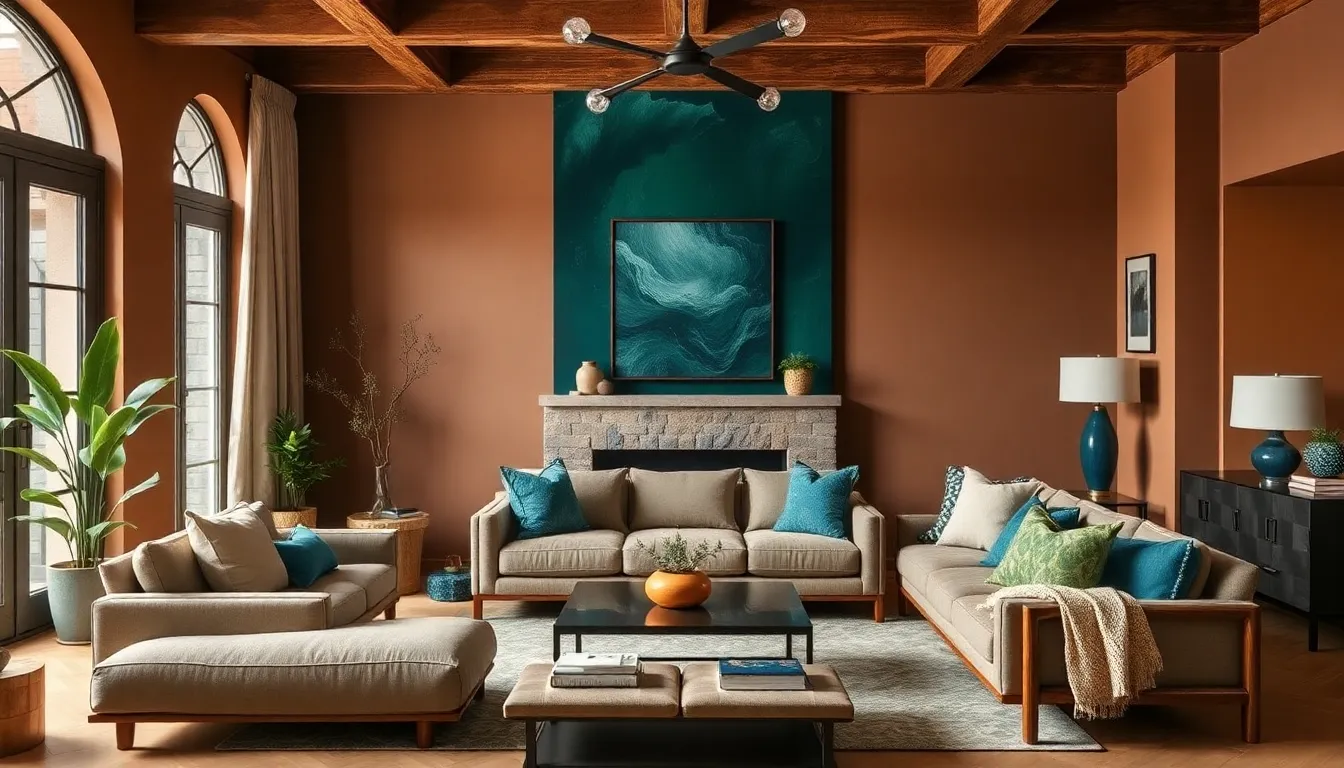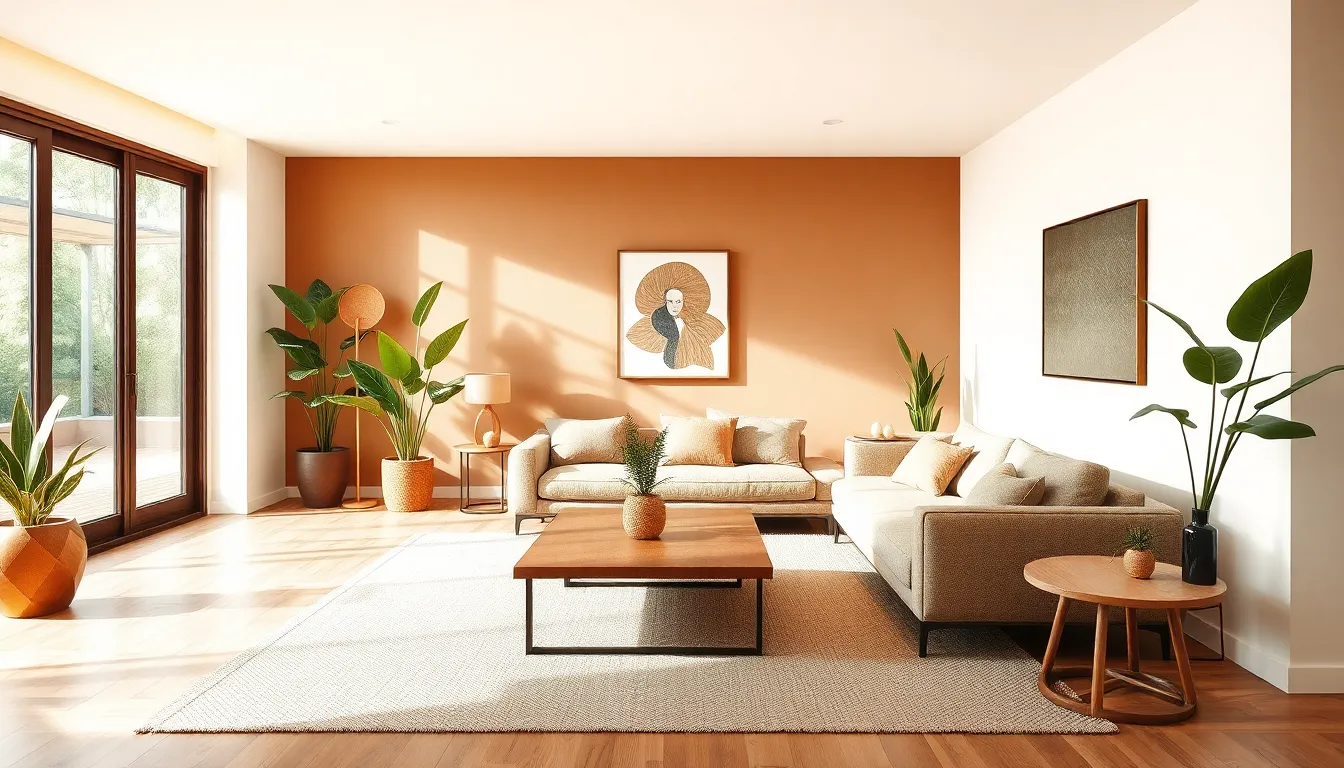In a world where first impressions matter, interior design trends can make or break a space faster than you can say “open concept.” Whether it’s a cozy nook or a sprawling mansion, the right design elements can transform a dull room into a jaw-dropping masterpiece. Who wouldn’t want their home to feel like a million bucks—without actually spending it?
Table of Contents
ToggleOverview of Interior Design Trends
Interior design trends evolve annually, reflecting changes in lifestyle, technology, and cultural preferences. Current trends prioritize sustainability, innovation, and personalized spaces, allowing homeowners to create environments that resonate with their unique tastes.
Biophilic design stands out by integrating natural elements into interiors. Plants, natural light, and organic materials enhance wellbeing and establish a connection with nature. This trend not only beautifies spaces but also improves air quality and promotes tranquility.
Another notable trend centers around minimalism. Clean lines and uncluttered spaces encourage simplicity and functionality. Neutral color palettes, paired with strategic pops of color, lead to serene and inviting environments.
Smart home technology has gained traction in modern designs. Automation systems enhance convenience and energy efficiency. Popular features include smart lighting, thermostats, and security systems, seamlessly integrated into the overall décor.
Multifunctional furniture continues to rise in popularity. Design solutions like convertible sofas and modular shelving maximize utility, especially in smaller spaces. These options facilitate organization without sacrificing style.
Textural diversity adds depth and interest to interiors. Combining various materials, such as wood, metal, and textiles, creates dynamic visual experiences. Homeowners embrace layering techniques, showcasing unique textures while maintaining cohesion.
Artisanal details emerge as a counterbalance to mass production. Handmade decor pieces add character and individuality to spaces. Unique artworks and locally sourced furniture reflect personal stories, enhancing the connection between inhabitants and their environments.
Recognizing and incorporating these trends leads to transforming spaces into reflections of identity. Each trend offers opportunities for creativity and expression, fostering environments that inspire and uplift.
Popular Color Palettes for 2023

In 2023, interior design embraces diverse color palettes that enhance aesthetic appeal and create inviting atmospheres.
Earthy Tones
Earthy tones, such as terracotta and olive green, dominate many interior spaces this year. These colors evoke a sense of calm and connection to nature. Soft browns and muted yellows add warmth and comfort, making spaces feel more inviting. Incorporating these shades can create a harmonious environment that promotes relaxation. Designers often pair earthy tones with natural materials, enhancing the organic feel of a room. Accessories in complementary shades, like deep blues and gentle creams, can also elevate the overall aesthetic.
Bold Hues
Bold hues like deep emerald, vibrant cerulean, and rich aubergine attract attention in contemporary interiors. These colors add energy and personality to any space, allowing for dynamic expression. Designers recommend using bold colors as accent walls or statement pieces, balancing with lighter tones to prevent overwhelming the room. Contrasting colors, such as bright yellows or fiery oranges, can create eye-catching focal points within a space. Functional decor items in these vibrant colors foster an atmosphere of creativity and inspiration.
Furniture Styles Gaining Popularity
Recent trends highlight unique furniture styles that enhance interior aesthetics. Homeowners prioritize functionality and design, opting for pieces that reflect contemporary living.
Minimalist Designs
Minimalist designs emphasize simplicity and clean lines. This style fosters a clutter-free environment, allowing spaces to feel more open. Furniture pieces, often in neutral tones, blend seamlessly with their surroundings. Natural materials like wood and metal create elegance without overwhelming decor. Single statement pieces draw attention while maintaining a serene atmosphere. These designs suit various spaces, from urban apartments to spacious homes, providing flexibility and modern appeal.
Multipurpose Furniture
Multipurpose furniture maximizes utility and space efficiency. Sofa beds and extendable dining tables serve dual functions, making them ideal for smaller living areas. Designers curate items that enhance both form and function, ensuring style doesn’t compromise practicality. Storage solutions integrated into furniture help maintain organization while contributing to aesthetics. Rows of modular shelving adapt to changing needs, making them highly versatile. These innovative pieces cater to busy lifestyles, supporting effortless living and modern conveniences.
Sustainable Interior Design Trends
Sustainable interior design trends emphasize eco-conscious choices and practices that enhance spaces while protecting the environment. Homeowners increasingly seek ways to incorporate these elements into their designs.
Eco-Friendly Materials
Sustainable materials gain traction among designers and homeowners. Bamboo, reclaimed wood, and recycled metals contribute to a lower carbon footprint while offering unique aesthetics. These materials provide durability and style, creating long-lasting interiors. Additionally, organic textiles like linen and cotton reduce harmful chemical exposure, promoting healthier living environments. Choosing low-VOC paints and finishes further ensures air quality remains intact. As homeowners prioritize eco-friendly options, the integration of these materials becomes vital for contemporary interiors.
Upcycling Practices
Upcycling practices transform old items into stylish decor. Innovative designers often repurpose furniture, giving new life to discarded pieces. For instance, turning vintage suitcases into chic side tables adds character while reducing waste. This approach supports creativity and sustainability within home design. Homeowners find joy in discovering unique additions that tell a story and reflect personal style. Communities embracing upcycling foster connections, making sustainable living an enjoyable and engaging experience. By integrating upcycled items, individuals create meaningful and environmentally friendly spaces.
Technology in Interior Design
Innovative technology transforms interior design, enhancing both functionality and aesthetic appeal. Smart home systems offer homeowners seamless control of lighting, climate, and security, integrating into the overall design effortlessly. Automated features increase convenience, allowing occupants to adjust settings remotely or via voice commands.
Augmented reality (AR) and virtual reality (VR) applications are revolutionizing the design process. Clients can visualize changes in real-time, ensuring the selected elements resonate with their personal style. Designers frequently use these tools for client presentations, enabling effective decision-making and minimizing costly mistakes.
3D printing introduces new possibilities for custom furniture and decor, allowing for unique design solutions tailored to individual preferences. This technology supports creative expression by enabling rapid prototyping of designs that can reflect personal stories.
Additionally, smart materials in interior design invite exciting innovations. Responsive textiles and surfaces react to environmental changes, providing dynamic characteristics that elevate the overall experience. As an example, temperature-regulating fabrics can enhance comfort in diverse climates.
Sustainable technology plays a crucial role in contemporary designs. Energy-efficient appliances and smart energy management systems reduce consumption while promoting eco-friendly living spaces. The integration of these elements ensures that interior spaces not only exude style but also support environmentally responsible practices.
Ultimately, technology fosters a new era in interior design, merging aesthetics with practicality. Homeowners enjoy spaces that reflect their desires and respond to their needs, resulting in personalized and inspiring environments. As trends evolve, embracing technological advancements significantly impacts how spaces are created, experienced, and sustained.
Staying updated with interior design trends is essential for creating spaces that truly reflect personal style. As homeowners embrace sustainability and technology, their environments evolve into functional yet aesthetically pleasing havens. The focus on natural elements and innovative materials fosters a sense of tranquility while promoting eco-conscious living.
Incorporating bold colors and multifunctional furniture not only enhances visual appeal but also maximizes utility, making it easier to adapt to changing lifestyles. Ultimately, these trends empower individuals to curate spaces that inspire and uplift, transforming ordinary rooms into extraordinary reflections of their unique identities.







